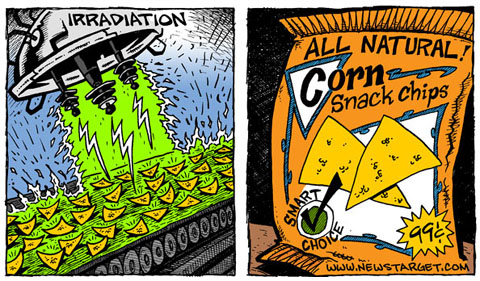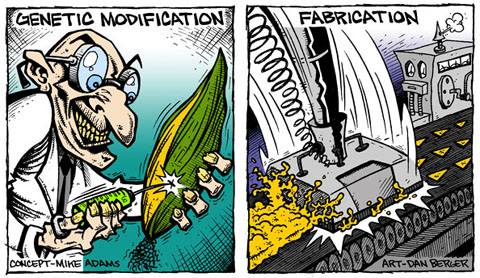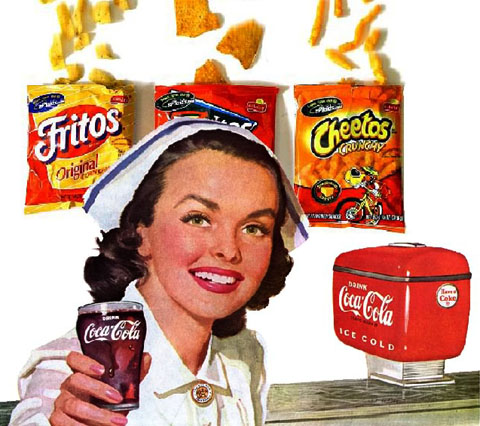[Normally
these columns are scheduled to appear every other Sunday in the Kauai
Garden Island News.The final published version may vary from this text
as TGI retains the right to correct and edit the material. The
copyright to the published version is held by TGI owner Kauai
Publishing. Some material in TGI columns may have appeared on
www.islandbreath.org already.]
by Juan Wilson on 2 March 2008 Revision 5.7 080229
Soylent Yellow
Once upon a time, the Iroquois nation learned to plant corn in a system
called "The Three Sisters": The technique was to plant corn on mounds
in a triad with squash and beans. The corn stood atop the mound and
supported the beans. The squash surrounded the base of the mound and
protected it. Each plant added chemical, hormonal and mechanical
advantages to the other two. Fish heads were added to the mound as a
secret ingredient to get things started. Together these plants provided
a complete protein addition to the diet of the Iroquois. The Three
Sisters have lasted for centuries.
Today, if you go to the snack food, beverage or pet food aisles of your
supermarket, you'll be up to your eyeballs in corn. You've seen it - in
the snack aisle the stacks of bagged Fritos, Cheetos and Tostados as
high as you can reach.
In the beverages aisle, the three liter soda bottles hold high-fructose
corn syrup (HFCS) mixed with water, at 100 calories per serving. And
when then you drink a 40 once can of of Cran-Apple juice drink, unless
you're buying a product labeled "100% JUICE", you're really swilling
water mixed with HFCS and trace amounts of some bulk fruit concentrate.
The HFCS tastes as sweet as cane sugar, but is easier to ingest in
large quantities. You never get satiated, as with cane sugar - and
guess what - it's cheaper.
The remaining food aisles are also affected. Even a plain can of tomato
paste, or a package of hot dogs now contains the magic ingredient of
corn syrup.
The pet food aisle is no better. Like most, if you're feeding your
beloved cat or dog dry kibble they are actually surviving on a
variation of cornmeal with meat-like flavorings.
Not only are your pets made of corn, so is the pork and beef that you
eat. Corn is the primary feed given to pigs, cows and chickens; it's mixed with
hormones, antibiotics and a little of their own protein (the latter is
the reason for mad cow disease).

image above: bottom of cartoon by Mike Adams & Dan Berger for www.newstarget.com
The Children of the Corn
Why should we worry about corn based Coke and Cheetos? Why should we
care that 40% of supermarket food contains HFCS? Because three-quarters
of Americans are overweight and over a third of us are categorized as
obese. In fact, between 1980 (when HFCS hit the shelves) and 2000, our
obesity rate has doubled.
The products containing corn syrup have been directly connected to our
problems with obesity. The biggest health risks facing our nation are
heart disease and diabetes. They both result from obesity. As it stands
today, almost half of mature Americans are considered pre-diabetic.
The increased consumption of industrialized corn products in our diet
is no accident. There is an interlocking set of interests that has
created a huge agricultural corn industry that involves Monsanto, ADM,
Cargill, Tyson, Swift and others.
A new element of the corporate corn industry is one of the biggest
boondoggles in American agricultural history. A swindle of staggering
proportions - Ethanol.
Ethanol will not save the planet from global warming. It will not
provide an alternative energy source we can rely on. It will, however
create additional demand for corn. The increased demand for corn as a
fuel additive will compete with its use as a food additive. The result
is both food and fuel will be more expensive. A double whammy on the
public.
King Corn Rules
In 2007, three-quarters of all U.S. corn planted were Genetically
Modified Organisms (GMO's). Two-thirds of that GMO corn came from three
companies that develop their seed corn here on Kauai. Those GMO
companies are Monsanto (Dekalb), DuPont (Pioneer) and Syngenta. Besides
disease and chemical resistance, their genetic modification allows for
linking a patented corn seed with copyright markers, requirements for
specific chemical treatments, and even chemical triggers for
germination and suicide . Some call this stuff Frankenfood.
U.S. farmers planted over 90 million acres of corn last spring, up 15
percent from the year before. That is an area almost as big as
California. Most of this "Corn Basket" crop is concentrated in the
Midwest's Mississippi River Basin. Mono-crop corn production has caused
erosion and soil run-off. The overuse of pesticides and fertilizers has
created a flow of toxic chemicals that follow the soil down the
Mississippi River to the Gulf of Mexico. This brew, including much
nitrogen and phosphorous, has created a "Dead Zone" in the Gulf of
Mexico as big as the state of New Jersey.
There is a giant pyramid of destruction that flows down from the seed
corn producers here on Kauai and spreads across the world. The
agricultural strategy of these GMO companies is to own all life.
 image above: top of cartoon by Mike Adams & Dan Berger for www.newstarget.com image above: top of cartoon by Mike Adams & Dan Berger for www.newstarget.com
What do we have to fear?
In the 1958 Hitchcock classic "North by Northwest", an innocent Cary
Grant gets off a bus in corn country in the heartland of America. The
bus disappears in the distance and Grant is left standing in the middle
of cornfields that stretch as far as the eye can see. Soon, we hear the
sputter of an old biplane spraying pesticides on the corn. The next
thing we see is the crop duster diving on Grant and attacking him. He
runs in fear, with nowhere to hide. That's how many feel living on
Kauai today.
Two examples of why you should be afraid if you live on Kauai:
Example One: Syngenta
Syngenta operates GMO seed-corn fields on the Mana Plain immediately
adjacent to Waimea Canyon Middle School. Syngenta sprays the herbicide
Touchdown on those fields. Three times since November of 2006, children
at the school have become ill after the spraying. Teachers and parents
have complained. Children have had to go to the hospital. Syngenta says
it is not the herbicide but the smell of stinkweed that has caused a
hysteria in the community. They claim Touchdown is perfectly safe to
breath when they apply it.
Gary Hooser introduced a bill to create a herbicide-free buffer around
schools in Hawaii to protect our children. In the public hearing, the
representatives of the Lingle administration's departments of
agriculture, health and education all testified against the need for
such a bill. After all, Touchdown is safe. After great public pressure,
the company has delayed spraying that particular field for the rest of
2008.
Example Two: Monsanto
Monsanto subleases most of the Alexander and Baldwin land in Hanapepe
Valley. That represents a large part of the productive farmland in the
valley where food crops like taro and rice were grown in the past.
Monsanto's Dekalb seed company develops GMO seed-corn there.
On Sunday 3 February TGI News reported "...shortly after 6 pm. in
Hanapepe, a 40-foot shipping container carried by the rain-swollen
Hanapepe River struck the bridge and required police to close it for a
time, according to emergency frequency traffic. Police were calling for
a structural engineer to assess the damage before reopening it."
County workers warned residents that there were two more containers up
the river that might come down and strike bridges or even block the
flow of water under them. Eye witnesses claim the floating container
broke open when it hit the main highway bridge and some say they
smelled pesticides and saw warning labels on packaging.
This container continued out into Hanapepe Bay. It may still be spewing
its contents out onto the reefs and possibly affecting nearby Salt Pond
Beach Park. Monsanto has made no statement about the contents of the
container or made any public efforts to retrieve it.
The alternative to Frankenfood
We do not want our children to be the guinea pigs in a genetic
experiment. We do not want industrial scale applications of pesticides
and chemicals on our island. We do not want our productive farmland
tied up by multinational corporations.
No one really knows what long term health effects eating genetically
modified corn, but one thing is clear - this corn uses too much energy,
synthetic fertilizers, pesticides, refinement, packaging and
transportation - obviously this is not a sustainable business plan.
The path the GMO companies are on is leading to higher energy and food
prices. The corporate petrochemical-dependent plan to own the means of
producing food and energy won't save the planet in an Post Peal Oil
world... their efforts will only make things worse.
What we need is to grow our own food here on Kauai. Every experimental
corn plot is a field that could otherwise be used to produce local
organic vegetables, eggs, dairy or meat to feed the people of Hawaii.
The solution for Kauai is for the GMO companies to phase out of their current operations here.
• First, we should create a wide No-Pesticide-Spray buffer around
not only our schools, as proposed by Gary Hooser, but also to buffer
residential neighborhoods and existing traditional agland.
• Second, the GMO companies should begin a turn over a portion of
their leased land for non-GMO use. They should provide plots for
Community Gardens next to schools and residential areas. This should
include their own efforts at establishing sustainable organic farming
practices here on Kauai that utilize their current employees.
• Third, the these companies should plan on a limited time for the
continuation of their current GMO experiments on this island - a
complete phase out of open field GMO tests and pesticide use by 2013.
• Lastly, I urge the GMO companies to take a long hard look at the
future and realize that local organic farming will need to be started
en masse throughout the world and that they should be a part of it.
Their technical expertise could be invaluable.
|



 image above: top of cartoon by Mike Adams & Dan Berger for
image above: top of cartoon by Mike Adams & Dan Berger for